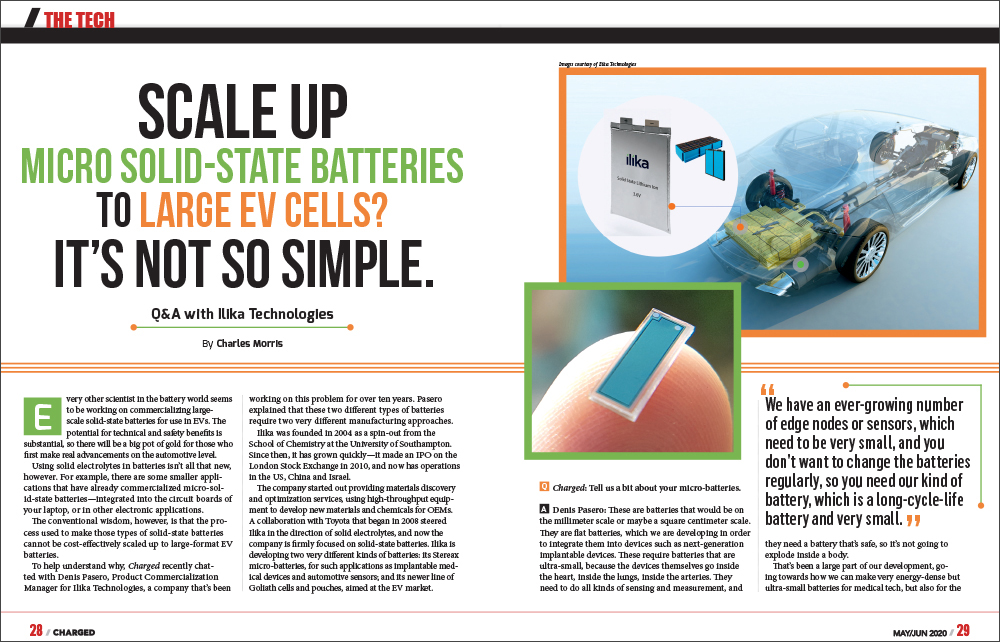Q&A with Ilika Technologies
Every other scientist in the battery world seems to be working on commercializing large-scale solid-state batteries for use in EVs. The potential for technical and safety benefits is substantial, so there will be a big pot of gold for those who first make real advancements on the automotive level.
Using solid electrolytes in batteries isn’t all that new, however. For example, there are some smaller applications that have already commercialized micro-solid-state batteries—integrated into the circuit boards of your laptop, or in other electronic applications.
The conventional wisdom, however, is that the process used to make those types of solid-state batteries cannot be cost-effectively scaled up to large-format EV batteries.
To help understand why, Charged recently chatted with Denis Pasero, Product Commercialization Manager for Ilika Technologies, a company that’s been working on this problem for over ten years. Pasero explained that these two different types of batteries require two very different manufacturing approaches.
Ilika was founded in 2004 as a spin-out from the School of Chemistry at the University of Southampton. Since then, it has grown quickly—it made an IPO on the London Stock Exchange in 2010, and now has operations in the US, China and Israel.
The company started out providing materials discovery and optimization services, using high-throughput equipment to develop new materials and chemicals for OEMs. A collaboration with Toyota that began in 2008 steered Ilika in the direction of solid electrolytes, and now the company is firmly focused on solid-state batteries. Ilika is developing two very different kinds of batteries: its Stereax micro-batteries, for such applications as implantable medical devices and automotive sensors; and its newer line of Goliath cells and pouches, aimed at the EV market.
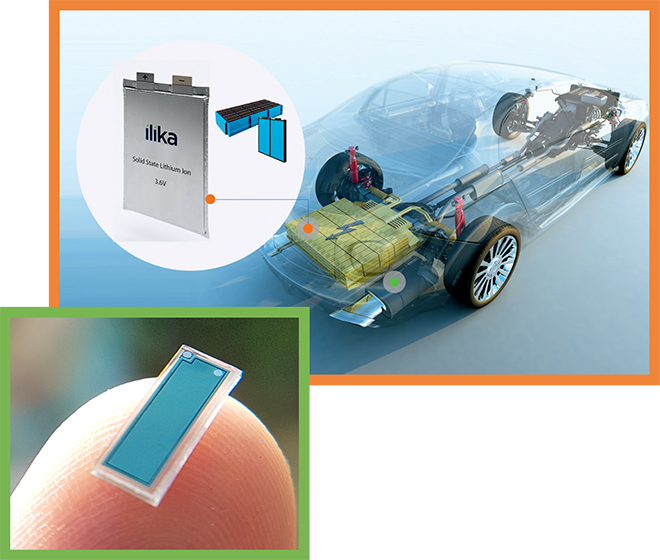

Charged: Tell us a bit about your micro-batteries.
Denis Pasero: These are batteries that would be on the millimeter scale or maybe a square centimeter scale. They are flat batteries, which we are developing in order to integrate them into devices such as next-generation implantable devices. These require batteries that are ultra-small, because the devices themselves go inside the heart, inside the lungs, inside the arteries. They need to do all kinds of sensing and measurement, and they need a battery that’s safe, so it’s not going to explode inside a body.
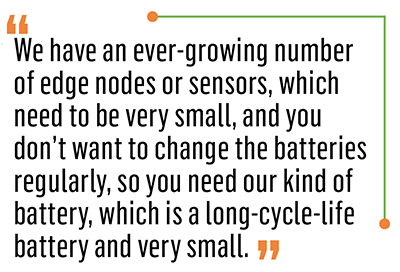

That’s been a large part of our development, going towards how we can make very energy-dense but ultra-small batteries for medical tech, but also for the Internet of Things (IoT) sector, particularly in the industrial environment, where everything is becoming more and more automated and interconnected. We have an ever-growing number of edge nodes or sensors, which need to be very small, and you don’t want to change the batteries regularly, so you need our kind of battery, which is a long-cycle-life battery and very small.
We are developing those batteries for various applications, but have not yet fully commercialized them. We are currently selling other prototype-level batteries. For example, in the industrial IoT world, sensing equipment that goes inside semiconductor furnaces and growth deposition chambers. When companies make wafers with silicone chips, they need a whole lot of measurements around that. Our batteries go to high temperatures—they go to 150° C, so that works very well inside those furnaces.
We successfully completed a £15-million equity placement a couple weeks back for a proper technology transfer and scale-up into a fabrication facility, so we have a road map, and now the funding, to go into mass production of those batteries.
Charged: How did you get into working on automotive batteries?
Denis Pasero: We started working with Toyota 12 years ago, then we moved away from the EV market for about 10 years, but in those 10 years we gained a lot of expertise in materials and processes. And alongside that, the world is changing, and we began to understand that some of our solid-state battery technology could also be used in electric vehicles. In the last two years we’ve started a project to develop those EV batteries. We are currently being funded by the UK government in a variety of collaboration projects with automotive OEMs, but also design houses and companies that make battery packs and thermal management systems and battery management systems. This is early days for us in this particular market, but we do aim to provide cells for evaluation next year.
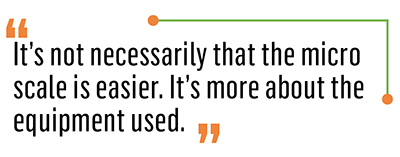

Charged: Are you trying to adapt the same kind of chemistry and manufacturing processes from the micro level to the larger cells, or are you working on a separate formulation altogether?
Denis Pasero: That’s a good question. This is basically what we thought about first—can we scale up from milliwatt-hours to watt-hours by using the same chemistry and processes? And, technically, we probably could, but the price would not be attractive at all. Some of the chemistries are quite similar, but the processes needed to be quite different to get to a price point that’s attractive for the EV market. Whereas the micro batteries are deposited in semiconductor-type deposition chambers, the batteries for EVs are deposited with more conventional printing techniques and inks and so forth.
It’s not necessarily that the micro scale is easier. It’s more about the equipment used. The semiconductor industry has equipment already available, which can be adapted to make batteries the size of a silicon chip. This is why we can make those batteries at a similar cost base. However, this is not equipment that can be adapted for making kilowatt-hours of batteries every day. They don’t have that kind of throughput. It’s a scale thing. The semiconductor industry equipment will make small things at a good price point, but that’s not adapted to making films, roll-to-roll films of great length.


Charged: What is your approach for developing large format solid-state cells?
Denis Pasero: We’re trying not to disturb the very active lithium-ion battery technology by using brand new equipment and processes, so we want to be using a lot of similar equipment—ink-based deposition of films on substrates, drying and lamination and so forth. We are trying to integrate as many technologies as possible from the lithium-ion battery world, but there will be some differences. The main difference, of course, is that the electrolyte is not a liquid. It’s not even a polymer or a gel. We are going for completely solid ceramic films. So, the deposition and creation of the electrolyte layer, its interaction with the cathode and anode layer, making sure the interfaces are good, it requires a slightly different type of equipment.
Charged: Are you developing this solid electrolyte with a specific cathode and anode formulation in mind, or do you think it’ll be varied depending on the customer?
Denis Pasero: At this stage we are using available formulations from the industry. We are not inventing new anodes or cathodes for this particular purpose. So, this is very much about using current and future materials with new processes. What I mean is that there is a sense that a solid-state battery could use, let’s say high nickel content, NMC materials, or even possibly just pure lithium nickel type materials much more effectively, in fact in a much more stable manner than a liquid-based electrolyte. The interface between a liquid and such cathodes is well known for not being so stable, but it could be for solid-state materials.


We are going for a full solid-state ceramic film. The gel and polymer electrolytes are sometimes called solid-state as well, so it is confusing. But semi-solid is a better way of describing them. We’re not using these at all.
The advantage of ceramic films is that we believe you can reach much higher energy density than even polymer- or gel-based lithium-ion batteries. Lithium-ion batteries have been evolving for some decades now. Energy density is going a little bit higher every year. There seems to be a theoretical limit for the energy density of conventional lithium-ion batteries, which at some point will plateau. New technologies—lithium air, lithium metal, lithium sulfur, but also solid-state—can theoretically provide up to 500 watt-hours per liter. We’re not there yet of course, but there is the potential. That’s the advantage.
The difficulty is at a technical level. Can you ensure that a solid cathode next to a solid electrolyte next to a solid anode communicate and transfer lithium ions very well? That’s actually quite a challenge. You need for those layers to have low resistance at the interfaces, so what you try to do is grade one layer into another. If you don’t do that, you’ll have sluggish, high-energy but low-power batteries. So that’s the challenge, and we’re working very much on making sure the interfaces and the layers are in good contact.
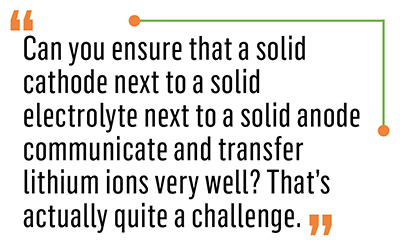

Charged: Is that interface challenge mostly about chemistry or manufacturing techniques?
Denis Pasero: It’s a mixture of chemistry and processes. It’s processes that allow a good link between the various components of the batteries. But there are also tricks like additional chemicals at the interfaces, which is also helping.
Charged: What are the next steps for your large-format batteries? What are the near-term goals?
Denis Pasero: The first two years of this endeavor were UK government-funded. And that allowed us to get the basis of some alpha prototype cells. The next step is to increase the energy density and start packing cells into pouch cells and next into packs. We do have partners that are dying to evaluate our batteries, looking for more. But the next step is going from alpha cells to pouch cells, and then to start evaluating them within packs.
Charged: What sort of partners are you looking for?
Denis Pasero: We’re always going to talk to the end user, the automotive OEMs, because they tell us what they need, and we get the specs straight from their mouth. We are creating a kind of ecosystem, which we call “lead partnership,” of people who know how to design packs, people who know how to design battery management systems, which is not at all in our DNA. But the last thing we want to do is make cells that are irrelevant to the end user, so talking to those people is very useful to us.
This article appeared in Charged Issue 49 – May/June 2020 – Subscribe now.




